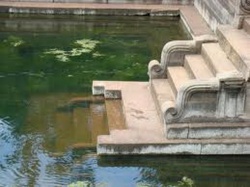Anurādhapura
Anurādhapura: The capital of Ceylon for nearly fifteen centuries. It was built on the site of settlements started by the two Anurādhas on the bank of the Kadamba river, and was founded under the constellation Anurādha, hence the name. MT.293; Mhv.x.76; this tradition seems to have been forgotten later, for in the Mbv. (116) there is a suggestion that the city was so called because it was the dwelling of satisfied people (anurodhijana); or is this mere alliteration?
Pandukābhaya (394-307 B.C.) was the founder of the city, to which he removed the capital from Upatissagāma (Mhv.x.75-7), and there it remained up to the time of Aggabodhi IV. (A.D. 626-41). After a short period it became once more the capital, and continued to be so until the royal residence was removed elsewhere (see Cv.xlvi.34, where the new capital, Pulatthinagara, is first mentioned as a royal residence). It was finally deserted in the eleventh century.
Pandukābhaya beautified the city with the artificial lakes Jayavāpi and Abhayavāpi. It was round the last-named lake that the king laid out the city, including four suburbs, a cemetery, special villages for huntsmen and scavengers, temples to various pagan deities and residences for the engineer and other officials. Abodes were also provided for devotees of various sects, such as the Jainas, the Ajīvakas, wandering monks and brahmins. There were also hospitals and lying-in homes. Guardians of the city (Nagaraguttikā) were appointed, one for the day and another for the night. For a full description see Mhv.x.80-102.
Pandukābhaya's son and successor, Mutasiva, laid out the beautiful Mahāmegha Park with fruit and flowering trees (Mhv.xi.2); this was to the south of the city; between it and the southern wall of the city was another park called Nandana or Jotivana (Mhv.xv.2, 11).
In the reign of Piyatissa, who succeeded Mutasiva (when Buddhism had been introduced into the land), the king, together with his nobles and people, erected many noble edifices in support of the new religion. Ten of the most noted were in Anurādhapura (for list see Mhv.xx.17ff), and the Mahāmeghavana, which was given over to the Buddhist Sangha, henceforth became the centre of Buddhism in the island. In this park was also planted, by Piyatissa, the branch of the Sacred Bodhi Tree which came from Gayā (for details see Mhv.xviii. and xix).
Soon afterwards the city was taken by the Tamils but was recaptured by Dutthagāmani (101-77 B.C.), the hero of the Mahāvamsa. Many chapters of the chronicle are devoted to descriptions of the numerous buildings erected by him in Anurādhapura for the glorification of the national faith (Mhv. xxvi.-xxxvi), chief among them being the Maricavatti-vihāra, the Lohapāsāda and the Mahā Thūpa.
A few years later the Tamils once more overcame the city and held it till Vattagāmani (29-17 B.C.) drove them off. In his reign was built the mighty Abhayagiri Thūpa and the vihāra attached to it (Mhv.xxxiii.80-3).
The subsequent history of the city is a record of how succeeding kings repaired, added to, or beautified, these various monuments and the steps they took for their preservation. The only later monument of real importance is the Jetavanārāma built by King Mahāsena (Mhv.xxxvii.33f ) (A.D. 334-61).
About this time the fame of Anurādhapura as the chief centre of Buddhist culture attracted many visitors from abroad in search of learning. The most famous of these was the great commentator Buddhaghosa (Mhv.xxxvii.215ff.; also Fa Hien). It was also during this period that Dhātusena (A.D. 460-78) reorganised the water supply of the city and built the Kālavāpi (Mhv.xxxviii.42).
From this time onward the country suffered from a series of dynastic intrigues and civil wars, each party appealing to the Tamils of South India for help and protection. As a result, the district round Anurādhapura was overrun by Tamil freebooters and became impossible to defend; the seat of government was therefore removed to Pulatthipura about the beginning of the ninth century, where it continued, except for a brief interval to the eleventh century. Finally, about A.D. 1300, at a date not exactly known, the whole district was abandoned, having become a kind of no-man's land; it then rapidly relapsed into jungle. For quite a long time, however, and even after Pulatthipura became the state capital, Anurādhapura was regarded as a centre of religious activity, and its monuments were restored from time to time (Mhv.lxxvi.106-20; lxxviii.96f.; xxxxviii.80f.
Various scraps of information regarding Anurādhapura and its inhabitants are found scattered in the commentaries. E.g., that it had two indakhīlas (Sp.iii.299); its main street ran from Thūpārāma, where the chief entrance to the city lay (UdA.238; DA.ii.573).
It was famous throughout Jambudīpa for its virtuous monks, and men came from there to visit them. E.g., the brahmin who came from Pātaliputta to see Mahānāga Thera (AA.i.384).
The city wall, which existed at the time the Mahāvamsa was written, had been built by King Vasabha (Mhv.xxxv.97), and was, according to the Tīkā (p. 654), eighteen cubits in height.

